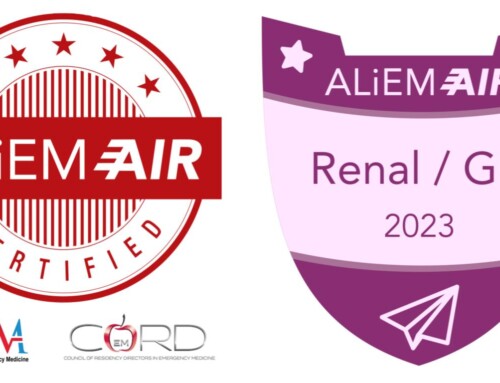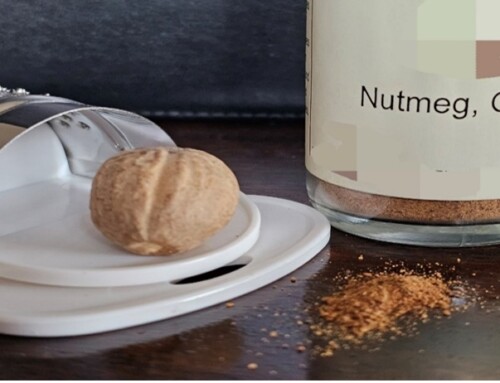
Read this tutorial on the use of point of care ultrasonography (POCUS) for pediatric renal and bladder ultrasonography. Then test your skills on the ALiEMU course page to receive your PEM POCUS badge worth 2 hours of ALiEMU course credit.
Module Goals
- List the indications for performing a pediatric renal/bladder point-of-care ultrasound (POCUS)
- Describe the technique for performing renal/bladder POCUS
- Identify hydronephrosis and its appearance at different severities
- List the limitations of renal/bladder POCUS
- Advanced: Recognize direct and other indirect signs of nephrolithiasis as well as gross renal/bladder structural anomalies such as cysts and masses
Case Introduction: Child with abdominal pain
Serena is a 9-year-old girl who comes into the emergency department complaining of one day of left flank and left lower quadrant pain (LLQ). The pain is intermittent, sharp, severe, and associated with 2 episodes of nonbloody, nonbilious emesis. Her mother denies any fevers, upper respiratory symptoms, sore throat, or diarrhea. She adds that her daughter has complained of 2-3 episodes of dysuria and gross hematuria over the last few days.
On arrival, her vital signs are:
| Vital Sign | Finding |
|---|---|
| Temperature | 99 F |
| Heart Rate | 115 bpm |
| Blood Pressure | 97/50 |
| Respiratory Rate | 19 |
| Oxygen Saturation (room air) | 100% |
You find her lying on the gurney, uncomfortable appearing, and intermittently crying. She has a normal HEENT, neck, cardiac, respiratory, and back examination. She has no flank tenderness, but she does cry out with palpation of the LLQ and suprapubic areas.
Given her pain with a history of intermittent hematuria and dysuria, you perform a renal and bladder point of care ultrasound (POCUS) examination.
Pediatric Renal and Bladder POCUS
Case POCUS
Using the curvilinear probe, you perform a POCUS on the bladder and both kidneys (Video 12).
Video 12. Bilateral renal ultrasound demonstrating twinkling artifact in the bladder and left-sided moderate hydronephrosis, indicative of a distal left ureteral stone (Video courtesy of Dr. Jim Tsung)
Case Resolution
Labs showed a slight leukocytosis with a serum WBC of 13 x109/L but no left shift and a normal creatinine. Urinalysis was positive for blood, RBC’s, and crystals but negative for glucose, ketones, leukocyte esterase, nitrites, WBC’s, squamous cells, and bacteria. The pain and vomiting were well-controlled with ketorolac and ondansetron, respectively. Urology was consulted and recommended medical management. The patient was discharged on tamsulosin and given urine-straining instructions.
Pediatrician Clinic Follow-Up
At her pediatrician clinic visit 2 weeks later, the patient had passed the stone and was asymptomatic.
Learn More…
References
- Paliwalla M, Park K. A practical guide to urinary tract ultrasound in a child: Pearls and pitfalls. Ultrasound. 2014 Nov;22(4):213-22. doi: 10.1177/1742271X14549795. Epub 2014 Nov 10. PMID: 27433222; PMCID: PMC4760558.
- Deschamps J, Dinh V, Ahn J, et al. Renal Ultrasound Made Easy: Step-By-Step Guide. POCUS101.com. [cited 2023 July 4].
- Sethi SK, Raina R, Koratala A, Rad AH, Vadhera A, Badeli H. Point-of-care ultrasound in pediatric nephrology. Pediatr Nephrol. 2023 Jun;38(6):1733-1751. doi: 10.1007/s00467-022-05729-5. Epub 2022 Sep 26. PMID: 36161524; PMCID: PMC9510186.
- Milla, Sarah; Lee, Edward; Buonomo, Carlo; Bramson, Robert T. Ultrasound Evaluation of Pediatric Abdominal Masses, Ultrasound Clinics, Volume 2, Issue 3, 2007, Pages 541-559.
- Koratala A, Alquadan KF. Parapelvic cysts mimicking hydronephrosis. Clin Case Rep. 2018 Feb 21;6(4):760-761. doi: 10.1002/ccr3.1431. PMID: 29636957; PMCID: PMC5889270.
- Shelmerdine SC, Lorenzo AJ, Gupta AA, Chavhan GB. Pearls and Pitfalls in Diagnosing Pediatric Urinary Bladder Masses. Radiographics. 2017 Oct;37(6):1872-1891. doi: 10.1148/rg.2017170031. PMID: 29019749.
- Milling TJ Jr, Van Amerongen R, Melville L, et al. Use of ultrasonography to identify infants for whom urinary catheterization will be unsuccessful because of insufficient urine volume: validation of the urinary bladder index. Ann Emerg Med. 2005;45(5):510-513. doi:10.1016/j.annemergmed.2004.11.010
- Chen L, Hsiao AL, Moore CL, Dziura JD, Santucci KA. Utility of bedside bladder ultrasound before urethral catheterization in young children. Pediatrics. 2005 Jan;115(1):108-11. doi: 10.1542/peds.2004-0738. PMID: 15629989.
- Dessie A, Steele D, Liu AR, Amanullah S, Constantine E. Point-of-Care Ultrasound Assessment of Bladder Fullness for Female Patients Awaiting Radiology-Performed Transabdominal Pelvic Ultrasound in a Pediatric Emergency Department: A Randomized Controlled Trial. Ann Emerg Med. 2018 Nov;72(5):571-580. doi: 10.1016/j.annemergmed.2018.04.010. Epub 2018 Jul 3. PMID: 29980460.
- Pathan SA, Mitra B, Mirza S, Momin U, Ahmed Z, Andraous LG, Shukla D, Shariff MY, Makki MM, George TT, Khan SS, Thomas SH, Cameron PA. Emergency Physician Interpretation of Point-of-care Ultrasound for Identifying and Grading of Hydronephrosis in Renal Colic Compared With Consensus Interpretation by Emergency Radiologists. Acad Emerg Med. 2018 Oct;25(10):1129-1137. doi: 10.1111/acem.13432. Epub 2018 May 28. PMID: 29663580.
- Wong C, Teitge B, Ross M, Young P, Robertson HL, Lang E. The Accuracy and Prognostic Value of Point-of-care Ultrasound for Nephrolithiasis in the Emergency Department: A Systematic Review and Meta-analysis. Acad Emerg Med. 2018 Jun;25(6):684-698. doi: 10.1111/acem.13388. Epub 2018 Mar 25. PMID: 29427476.
- Kim SG, Jo IJ, Kim T, et al. Usefulness of Protocolized Point-of-Care Ultrasonography for Patients with Acute Renal Colic Who Visited Emergency Department: A Randomized Controlled Study. Medicina (Kaunas). 2019 Oct 28;55(11):717. doi: 10.3390/medicina55110717. PMID: 31661942; PMCID: PMC6915595.
- Sibley S, Roth N, Scott C, et al. Point-of-care ultrasound for the detection of hydronephrosis in emergency department patients with suspected renal colic. Ultrasound J. 2020 Jun 8;12(1):31. doi: 10.1186/s13089-020-00178-3. PMID: 32507905; PMCID: PMC7276462.
- Chandra A, Zerzan J, Arroyo A, Levine M, Dickman E, Tessaro M. Point-of-care ultrasound in pediatric urolithiasis: an ED case series. Am J Emerg Med. 2015 Oct;33(10):1531-4. doi: 10.1016/j.ajem.2015.05.048. Epub 2015 Jun 23. PMID: 26321169.
- Ng C, Tsung JW. Avoiding Computed Tomography Scans By Using Point-Of-Care Ultrasound When Evaluating Suspected Pediatric Renal Colic. J Emerg Med. 2015 Aug;49(2):165-71. doi: 10.1016/j.jemermed.2015.01.017. Epub 2015 Apr 29. PMID: 25934378.
- Gillon JT, Cohen SG. Diagnosis of Posterior Urethral Valves in an Infant Using Point-of-Care Ultrasound. Pediatr Emerg Care. 2021 Aug 1;37(8):435-436. doi: 10.1097/PEC.0000000000002393. PMID: 34397679


























